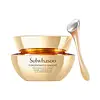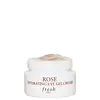What's inside
What's inside
 Key Ingredients
Key Ingredients

 Benefits
Benefits

 Concerns
Concerns

 Ingredients Side-by-side
Ingredients Side-by-side

Water
Skin ConditioningButylene Glycol
HumectantSqualane
EmollientGlycerin
HumectantPropanediol
SolventBehenyl Alcohol
EmollientDiisostearyl Malate
EmollientDimethicone
EmollientPolyglyceryl-3 Methylglucose Distearate
EmulsifyingHydrogenated Castor Oil Isostearate
Skin ConditioningPhytosteryl Isostearyl Dimer Dilinoleate
EmollientButyrospermum Parkii Butter
Skin ConditioningPhytosteryl/Behenyl/Octyldodecyl Lauroyl Glutamate
Skin ConditioningStearic Acid
CleansingGlyceryl Stearate
EmollientPEG-100 Stearate
1,2-Hexanediol
Skin ConditioningMethoxy PEG-114/Polyepsilon Caprolactone
BufferingPolyacrylate-13
Phenoxyethanol
PreservativePanax Ginseng Root Extract
EmollientPolyisobutene
Hydrolyzed Ginseng Saponins
Skin ConditioningCaffeine
Skin ConditioningHoney
HumectantAlcohol
AntimicrobialParfum
MaskingNelumbo Nucifera Flower Extract
Skin ConditioningPolygonatum Officinale Rhizome/Root Extract
Skin ConditioningRehmannia Glutinosa Root Extract
Skin ConditioningPaeonia Albiflora Root Extract
Skin ConditioningLilium Candidum Bulb Extract
Skin ConditioningEthylhexylglycerin
Skin ConditioningPolysorbate 20
EmulsifyingSorbitan Isostearate
EmulsifyingDisodium EDTA
Sodium Polyacrylate
AbsorbentTheobroma Cacao Extract
Skin ConditioningDextrin
AbsorbentGlycyrrhiza Uralensis Root Extract
Skin ConditioningAlpha-Isomethyl Ionone
PerfumingLimonene
PerfumingHydrogenated Lecithin
EmulsifyingLinalool
PerfumingPanax Ginseng Flower Extract
AntioxidantHydroxyisohexyl 3-Cyclohexene Carboxaldehyde
MaskingHexyl Cinnamal
PerfumingPhytosphingosine
Skin ConditioningSodium Polyaspartate
HumectantTocopherol
AntioxidantSodium Methyl Stearoyl Taurate
CleansingWater, Butylene Glycol, Squalane, Glycerin, Propanediol, Behenyl Alcohol, Diisostearyl Malate, Dimethicone, Polyglyceryl-3 Methylglucose Distearate, Hydrogenated Castor Oil Isostearate, Phytosteryl Isostearyl Dimer Dilinoleate, Butyrospermum Parkii Butter, Phytosteryl/Behenyl/Octyldodecyl Lauroyl Glutamate, Stearic Acid, Glyceryl Stearate, PEG-100 Stearate, 1,2-Hexanediol, Methoxy PEG-114/Polyepsilon Caprolactone, Polyacrylate-13, Phenoxyethanol, Panax Ginseng Root Extract, Polyisobutene, Hydrolyzed Ginseng Saponins, Caffeine, Honey, Alcohol, Parfum, Nelumbo Nucifera Flower Extract, Polygonatum Officinale Rhizome/Root Extract, Rehmannia Glutinosa Root Extract, Paeonia Albiflora Root Extract, Lilium Candidum Bulb Extract, Ethylhexylglycerin, Polysorbate 20, Sorbitan Isostearate, Disodium EDTA, Sodium Polyacrylate, Theobroma Cacao Extract, Dextrin, Glycyrrhiza Uralensis Root Extract, Alpha-Isomethyl Ionone, Limonene, Hydrogenated Lecithin, Linalool, Panax Ginseng Flower Extract, Hydroxyisohexyl 3-Cyclohexene Carboxaldehyde, Hexyl Cinnamal, Phytosphingosine, Sodium Polyaspartate, Tocopherol, Sodium Methyl Stearoyl Taurate
Water
Skin ConditioningMethyl Trimethicone
Skin ConditioningGlycerin
HumectantPropanediol
SolventPolyglycerin-3
HumectantSqualane
EmollientButylene Glycol
HumectantDimethicone
EmollientHydroxyethyl Acrylate/Sodium Acryloyldimethyl Taurate Copolymer
Emulsion StabilisingGlyceryl Oleate Citrate
EmulsifyingRosa Damascena Flower Water
MaskingChlorella Vulgaris Extract
Skin ConditioningRosa Damascena Extract
MaskingCucumis Sativus Fruit Extract
EmollientVoandzeia Subterranea Seed Extract
Skin ConditioningRhodiola Crenulata Root Extract
EmollientRosa Damascena Flower Oil
MaskingTocopheryl Acetate
AntioxidantDiphenylsiloxy Phenyl Trimethicone
Skin ConditioningCaprylic/Capric Triglyceride
MaskingPoloxamer 407
EmulsifyingDimethicone/Phenyl Vinyl Dimethicone Crosspolymer
PEG-6
HumectantPolysorbate 60
EmulsifyingSorbitan Isostearate
EmulsifyingXanthan Gum
EmulsifyingSodium Hyaluronate
HumectantSodium Citrate
BufferingCitric Acid
BufferingDisodium Phosphate
BufferingBiosaccharide Gum-2
Skin ConditioningC12-14 Pareth-12
EmulsifyingSodium Benzoate
MaskingPotassium Sorbate
PreservativePhenoxyethanol
PreservativeCaramel
Cosmetic ColorantCitronellol
PerfumingGeraniol
PerfumingWater, Methyl Trimethicone, Glycerin, Propanediol, Polyglycerin-3, Squalane, Butylene Glycol, Dimethicone, Hydroxyethyl Acrylate/Sodium Acryloyldimethyl Taurate Copolymer, Glyceryl Oleate Citrate, Rosa Damascena Flower Water, Chlorella Vulgaris Extract, Rosa Damascena Extract, Cucumis Sativus Fruit Extract, Voandzeia Subterranea Seed Extract, Rhodiola Crenulata Root Extract, Rosa Damascena Flower Oil, Tocopheryl Acetate, Diphenylsiloxy Phenyl Trimethicone, Caprylic/Capric Triglyceride, Poloxamer 407, Dimethicone/Phenyl Vinyl Dimethicone Crosspolymer, PEG-6, Polysorbate 60, Sorbitan Isostearate, Xanthan Gum, Sodium Hyaluronate, Sodium Citrate, Citric Acid, Disodium Phosphate, Biosaccharide Gum-2, C12-14 Pareth-12, Sodium Benzoate, Potassium Sorbate, Phenoxyethanol, Caramel, Citronellol, Geraniol
 Reviews
Reviews

Ingredients Explained
These ingredients are found in both products.
Ingredients higher up in an ingredient list are typically present in a larger amount.
Butylene Glycol (or BG) is used within cosmetic products for a few different reasons:
Overall, Butylene Glycol is a safe and well-rounded ingredient that works well with other ingredients.
Though this ingredient works well with most skin types, some people with sensitive skin may experience a reaction such as allergic rashes, closed comedones, or itchiness.
Learn more about Butylene GlycolDimethicone is a type of synthetic silicone created from natural materials such as quartz.
What it does:
Dimethicone comes in different viscosities:
Depending on the viscosity, dimethicone has different properties.
Ingredients lists don't always show which type is used, so we recommend reaching out to the brand if you have questions about the viscosity.
This ingredient is unlikely to cause irritation because it does not get absorbed into skin. However, people with silicone allergies should be careful about using this ingredient.
Note: Dimethicone may contribute to pilling. This is because it is not oil or water soluble, so pilling may occur when layered with products. When mixed with heavy oils in a formula, the outcome is also quite greasy.
Learn more about DimethiconeGlycerin is already naturally found in your skin. It helps moisturize and protect your skin.
A study from 2016 found glycerin to be more effective as a humectant than AHAs and hyaluronic acid.
As a humectant, it helps the skin stay hydrated by pulling moisture to your skin. The low molecular weight of glycerin allows it to pull moisture into the deeper layers of your skin.
Hydrated skin improves your skin barrier; Your skin barrier helps protect against irritants and bacteria.
Glycerin has also been found to have antimicrobial and antiviral properties. Due to these properties, glycerin is often used in wound and burn treatments.
In cosmetics, glycerin is usually derived from plants such as soybean or palm. However, it can also be sourced from animals, such as tallow or animal fat.
This ingredient is organic, colorless, odorless, and non-toxic.
Glycerin is the name for this ingredient in American English. British English uses Glycerol/Glycerine.
Learn more about GlycerinPhenoxyethanol is a preservative that has germicide, antimicrobial, and aromatic properties. Studies show that phenoxyethanol can prevent microbial growth. By itself, it has a scent that is similar to that of a rose.
It's often used in formulations along with Caprylyl Glycol to preserve the shelf life of products.
Propanediol is an all-star ingredient. It softens, hydrates, and smooths the skin.
It’s often used to:
Propanediol is not likely to cause sensitivity and considered safe to use. It is derived from corn or petroleum with a clear color and no scent.
Learn more about PropanediolSorbitan Isostearate is an emulsifer and cleaning agent. It is created from isostearic acid and sorbitol.
As an emulsifier, Sorbitan Isostearate prevents oils and water from separating.
Due to its isostearic acid base, it may not be safe for Malassezia or fungal acne.
Learn more about Sorbitan IsostearateSqualane is an emollient that helps the skin hold onto moisture. It's an oily liquid that occurs naturally in certain types of fish and plant oils.
Because squalane boosts hydration in the skin, it also comes with plenty of benefits: it is an antioxidant and can help fight free radicals and skin damage. Squalane is also found to have a detoxifying effect when applied.
Squalane comes from squalene, which occurs naturally within the sebum of our skin. It is one of the oils our skin produces to keep itself hydrated. Squalane is the hydrogenated version of squalene and has a longer shelf life.
Research shows that squalane is non-irritating (even at 100% concentration).
In general, it's a fantastic ingredient. It does a great job at hydrating the skin, and it's suitable for those with sensitive skin.
The source of squalane may impact malassezia / fungal acne. This is because olive oil derived squalane can contain impurities such as fatty acids and plant waxes. Sugarcane derived squalane is recommended for anyone with malassezia concerns.
Is squalane vegan?
This depends on the source. Squalane can be derived from both plants and animals. Most squalane used in skincare comes from plants.
Please note: the source of squalane is only known if disclosed by the brand. We recommend reaching out to the brand if you have any questions about their squalane.
Read more about squalene with an "e".
Is squalane an oil?
Squalane is often called an oil, but it’s technically not; it’s a hydrocarbon, meaning it’s only made of carbon and hydrogen, unlike true oils which are triglycerides made of fatty acids and glycerol.
The term “oil-free” isn’t regulated, so companies can define it however they want. Some exclude all oils, while others just avoid mineral oil or comedogenic oils.
While some people avoid oils thinking they cause breakouts, the right kind of oil (or oil-like ingredient like squalane) can actually help balance and hydrate your skin. It’s worth testing out simple oils or squalane to see what works best for your skin.
Learn more about SqualaneWater. It's the most common cosmetic ingredient of all. You'll usually see it at the top of ingredient lists, meaning that it makes up the largest part of the product.
So why is it so popular? Water most often acts as a solvent - this means that it helps dissolve other ingredients into the formulation.
You'll also recognize water as that liquid we all need to stay alive. If you see this, drink a glass of water. Stay hydrated!
Learn more about Water